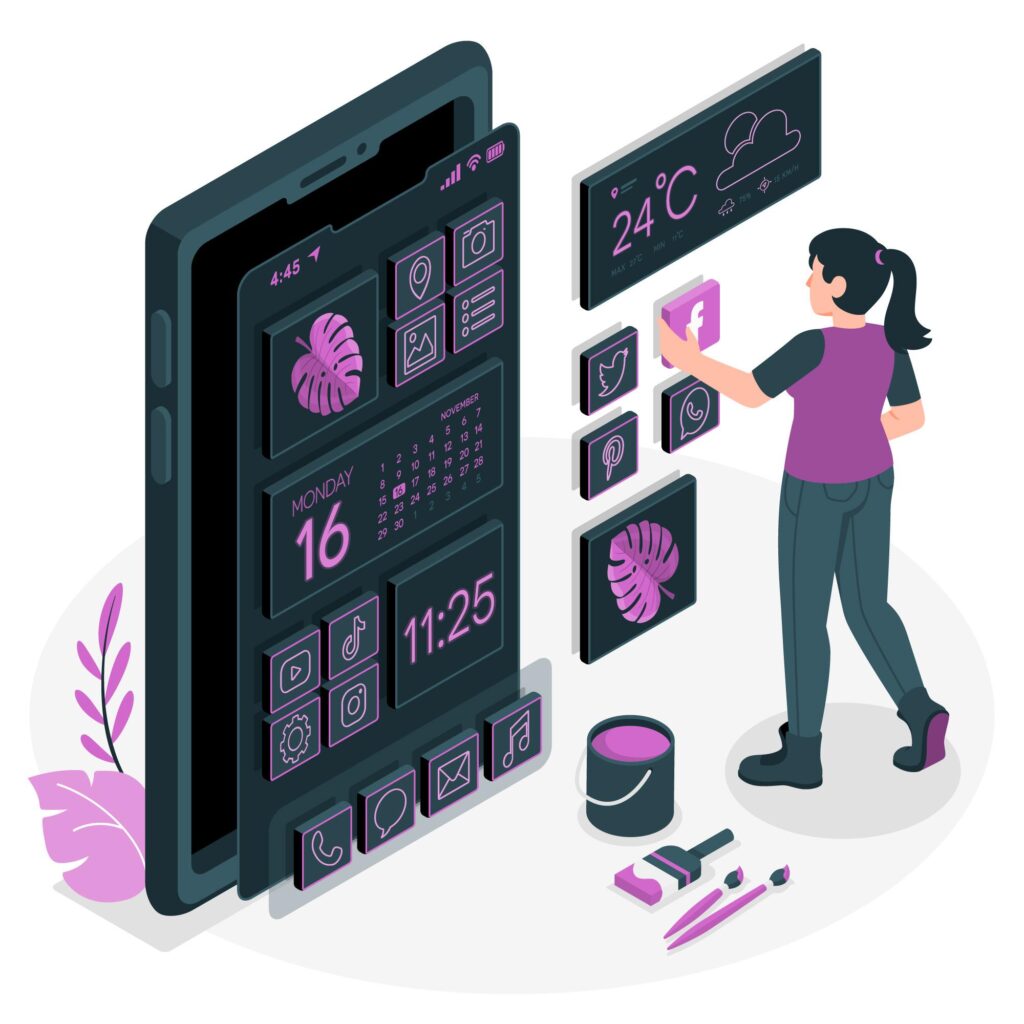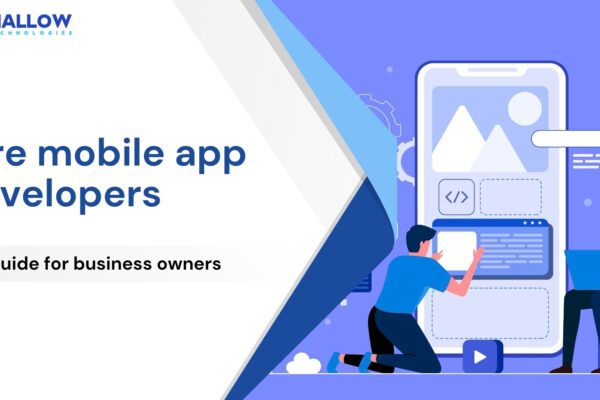In iOS app development, user-centric design is crucial for success. Ignoring user needs leads to poor experience, low engagement, compatibility issues, harm to brand reputation, and higher churn.
Our team of developers and designers at Mallow have years of experience navigating the evolving landscape of iOS mobile applications. We pride ourselves on our commitment to creating user-centric experiences that also prioritise seamless interactions and user satisfaction.
After reading this article you will get a comprehensive breakdown of strategies essential for creating successful iOS applications with a good user-centric design. The insights shared will help you to attain a well shaped user-centric design for your iOS application.
What is the role of user-centric design in iOS app development?

User-centric iOS app design is a strategic approach in iOS app development that puts the end-user at the heart of design decisions. It involves creating detailed representations of different user types based on real data about user demographics and behaviour to create apps that resonate deeply with the target audience and meet their needs flawlessly.
To create an impactful iOS app, grasping the synergy between UX and UI design is essential. While UX design focuses on the flow, functionality, and ease of navigation within the app, UI design encompasses captivating visuals, engaging animations, and an aesthetic that resonates with users.
Areas to focus on when optimising your iOS application for user-centric design

Research and conduct user analysis
Achieving user-centric design demands a deep understanding of your target audience. Rigorous user research, encompassing both qualitative and quantitative methods, is essential to uncover valuable insights. Techniques such as remote usability testing, surveys, and interviews are instrumental in this phase, offering a comprehensive view of user behaviors, expectations, and pain points . These methods are well-documented by the Interaction Design Foundation in their article on Remote Research Methods.
Crafting user personas is akin to breathing life into your data. These fictional representations combine demographic information, user behaviours, and goals, resulting in archtypes. User personas serve as guiding beacons throughout the design process, ensuring that the end product resonates with the diverse facets of your user base.
User-centric design hinges on deciphering what users truly need and prefer. Analysing data gleaned from user research and persona creation unveils patterns, allowing for the identification of common pain points and desires. This analysis serves as the compass for tailoring the application to align seamlessly with user expectations.
Wireframing and prototyping
Wireframes and prototypes serve as the visual storytellers of your application’s journey. Wireframing, the skeletal blueprint, outlines the structural elements and navigational flow. Prototyping, on the other hand, brings interactivity to the forefront, allowing stakeholders to engage with a functional representation. Tools like Sketch are particularly effective for creating precise prototypes tailored for Apple devices, as outlined in The Product Manager’s guide to mobile app prototyping tools.
These components collectively provide a tangible foundation for informed decision-making and collaborative refinement. From industry staples like Sketch, Adobe XD, and Figma to user-friendly platforms like InVision and Marvel, designers wield a diverse arsenal. Techniques vary from low-fidelity sketches to high-fidelity digital prototypes, each offering a distinct advantage in visualising and validating design concepts.
The beauty of user-centric design lies in its adaptability. The iterative design process, fueled by user feedback and evolving insights, finds its breeding ground in wireframing and prototyping. Designers engage in a cyclical rhythm of refinement, continuously fine-tuning the user interface based on user testing, stakeholder input, and emerging design trends. This iterative dance ensures that the final product is not just aesthetically pleasing but harmoniously aligned with user needs.
Keep a user-centred navigation
User-centric navigation begins with a deep understanding of user behaviour and expectations. Crafting intuitive navigation flows involves mapping out the user journey in a way that aligns seamlessly with their mental model. Through user research and feedback, designers can identify key touchpoints, streamline pathways, and eliminate unnecessary steps, ensuring that users can effortlessly navigate the application. iOS, with its distinctive design principles, embraces specific navigation patterns that contribute to a cohesive and user-friendly experience.
From tab bars and navigation bars to modal views and swipe gestures, understanding and leveraging these patterns enhances user familiarity and comfort. This section explores the nuances of incorporating iOS-centric navigation elements to create a cohesive and harmonious user interface.
The tactile nature of iOS devices opens avenues for implementing user-friendly gestures that elevate the user experience. From swipe gestures for effortless navigation to pinch and zoom functionalities for interactive content, thoughtful incorporation of gestures enhances usability and engagement. This segment delves into best practices for integrating gestures seamlessly, ensuring they enhance rather than complicate the user journey.
Accommodate visual design and branding
Ensuring a user-centric design for your iOS application is paramount to its success, as it directly impacts user satisfaction, engagement, and retention. Among the key elements contributing to this user-centric approach is the accommodation of visual design and branding.
A visually appealing and cohesive design not only creates a positive first impression but also establishes brand identity, fostering a sense of trust and familiarity. This section will guide you through essential considerations in accommodating visual design and branding for an optimised iOS application.
Step 1: Define branding guidelines
- Establish a clear set of branding guidelines that encapsulate the visual identity of the mobile application.
- Specify primary and secondary colors, typography, and iconography that align with the overall brand aesthetic.
Step 2: Create a consistent design language and prioritise visual hierarchy
- Ensure consistency in design elements such as colors, typography, and icons throughout the application.
- Establish design patterns that can be reused for a cohesive and recognizable user interface.
- Seamlessly integrate the app’s branding elements, including logos and taglines, into the visual design.
- Place branding elements strategically to enhance brand recall without compromising the overall user experience
- Define a clear visual hierarchy that guides users through the interface based on the importance of content and actions.
- Use color, size, and contrast judiciously to highlight key elements and interactions.
Step 3: Optimise for readability and accessibility
- Choose legible fonts and font sizes to ensure text readability on various device sizes.
- Prioritise accessibility by using colour combinations that comply with accessibility standards and providing alternative text for images.
- Embrace white space to create a clean and uncluttered interface.
- Use white space strategically to group related elements and enhance overall visual appeal.
Step 4: Implement responsive design
- Ensure the visual design adapts seamlessly to different screen sizes and orientations.
- Test the responsiveness of design elements to guarantee a consistent and user-friendly experience across devices.
Step 5: Conduct usability testing
- Test the visual design with real users to gather feedback on its appeal and effectiveness.
- Iterate based on user insights, refining the visual design to align more closely with user preferences.
Step 6: Iterate based on user feedback
- Actively seek user feedback on the visual design through surveys, reviews, and analytics.
- Iterate on the design based on user preferences, addressing pain points and enhancing overall satisfaction.
Consider accessibility and inclusivity
Ensuring that every user, regardless of ability, can navigate and engage seamlessly with your iOS application necessitates deliberate design choices and thoughtful implementation of accessibility features. iOS offers a robust suite of accessibility tools designed to support a wide range of needs—including those related to vision, hearing, motor skills, and learning as outlined by Apple on their Accessibility page.
Below you’ll find some tips to embed accessibility into the very fabric of your app, promoting a more inclusive digital experience for all users.
Ways to embed accessibility into your iOS application
- Incorporating accessibility features specific to iOS is crucial for ensuring that all users can interact with the application seamlessly. Leveraging features like VoiceOver, Switch Control, and AssistiveTouch provides users with disabilities the means to navigate and engage with the application effectively.
- Consider the accessibility of color choices, ensuring adequate contrast for users with visual impairments.
- Device-specific features such as font size adjustments, ensuring legibility for users with varying visual needs, and back swipe support for intuitive navigation, along with support for dark and light mode, further contribute to an inclusive and user-friendly experience.
- You should implement and test Dynamic Type to ensure that the application remains readable and usable across a range of font sizes. You can also explore other accessibility features such as Speech Recognition and Magnifier to provide diverse means of interaction.
Check the performance and responsiveness of your application
The seamless operation of an app hinges on its ability to optimise performance, efficiently handle data loading and processing, and minimise load times. Let’s delve into key strategies for achieving a responsive and high-performing mobile application.
Conduct thorough performance profiling to identify bottlenecks and areas for improvement.
Implement code optimisations, such as minimising redundant operations and leveraging caching mechanisms, to enhance overall app responsiveness.
Adopt asynchronous data loading techniques to prevent UI freezes during data retrieval. Implement pagination or lazy loading to fetch data incrementally, promoting a smoother user experience, particularly in content-heavy applications. Compress images and multimedia assets to reduce download times without compromising quality. Utilise content delivery networks (CDNs) for efficient content distribution, ensuring faster access to resources across diverse geographical locations.
Optimize the critical rendering path to prioritise the loading of essential elements first, enhancing the perceived speed of the application.Leverage techniques like code splitting to defer the loading of non-essential components until they are required, reducing the initial load time.
Offload resource-intensive tasks to background threads to prevent disruptions in the app’s foreground functionality. Leverage background processing for tasks like data synchronisation and updates to ensure a seamless user experience even during resource-intensive operations.
Collect user feedback and conduct testing
Gathering user feedback through diverse testing methodologies, including user testing, A/B testing, and usability testing, forms the bedrock of user-centric excellence. This section navigates the strategies for effectively soliciting and implementing user feedback, fostering a continuous cycle of improvement.
Conduct user testing sessions to observe and analyse how real users interact with the application.
Gather qualitative feedback on usability, navigation, and overall user experience, identifying pain points and areas for enhancement. Implement A/B testing to compare variations of specific features or design elements with actual users. Prioritise and implement enhancements based on user insights, ensuring that each iteration brings the app closer to an optimal user experience.
Key best practices for user-centric iOS app design

✅ Understand the needs and expectations of your target audience through thorough user research.
✅ Develop detailed user personas to guide design decisions based on user characteristics and behaviours.
✅ Ensure the integration of iOS accessibility features like VoiceOver, Switch Control, and AssistiveTouch.
✅ Accommodate device-specific features such as font size adjustments and back swipe support for varied user needs.
✅ Provide support for both dark and light mode to enhance visual comfort and flexibility for users.
✅ Craft navigation flows that align with user mental models, ensuring an intuitive user journey.
✅ Integrate iOS navigation patterns like tab bars and modal views for a consistent and familiar user experience.
✅ Incorporate user-friendly gestures, such as swipe gestures, to enhance interaction and engagement.
✅ Define a clear visual hierarchy to guide users through the interface based on content importance.
✅ Make sure you have your iOS application’s version updated so as to provide optimum performance and best user experience for your application users.
✅ Optimise data loading and processing to prevent UI freezes and ensure a smooth user experience.
✅ Engage in frequent usability testing to gather insights and identify areas for improvement.
✅ Integrate performance monitoring tools to track and analyse real-time app performance.
✅ Create comprehensive documentation highlighting the app’s accessibility features for user reference.
How can I validate the usability of my application?

By this point, you have acquired a thorough understanding of the pivotal areas crucial for establishing a user-centric design in your iOS application development. This overview brings into focus the key considerations that play a vital role in shaping a smooth and user-friendly experience.
With this valuable insight, you are well-equipped to steer through the journey of achieving an impeccable user-centric design, finely tuned to align with the needs and expectations of your target audience. For deeper insights, delve into our article that guides you on evaluating the usability of your application, offering detailed insights into the evaluation process.
Have questions about building or redesigning your iOS application? Feel free to reach out to us.
Your queries, our answers
Mobile application development involves creating software applications designed to run on mobile devices like smartphones and tablets. These apps can be native (built specifically for iOS or Android), cross-platform (designed to work on multiple platforms), or hybrid (combining elements of both).
Our mobile app development process includes the following stages: requirement gathering and analysis, design and prototyping, development and coding, testing and quality assurance, deployment, and post-launch support. Each stage is crucial to delivering a high-quality application.
To gain deeper insights into the experience of working on a mobile project with Mallow, explore more details here.
The choice between native and cross-platform development depends on your project’s goals, budget, and target audience. Native apps offer better performance and a more tailored user experience, while cross-platform apps allow for faster development and lower costs by using a single codebase for multiple platforms. For a detailed comparison of Native vs. Hybrid development, explore our comprehensive analysis to help you make an informed choice.
Mallow develops mobile apps for iOS, Android, and cross-platform solutions. We use the latest technologies and frameworks to ensure your app performs optimally on the platforms that matter most to your users.
Choosing the right features for your mobile app depends on understanding your target audience, business goals, and budget. We work closely with you to prioritize features that will provide the most value to your users and align with your business objectives.
At Mallow, we offer ongoing app maintenance and updates as part of our post-launch services. This includes regular updates to improve performance, add new features, and ensure compatibility with the latest operating systems. For more details, get in touch with our team.
Yes, Mallow assists with the entire app store submission process, including meeting the guidelines for Apple’s App Store and Google Play. We ensure your app is ready for submission and provide support to help it get approved.
Mallow uses a variety of technologies and frameworks for mobile app development, including Swift and Objective-C for iOS, Kotlin and Java for Android, and React Native and Flutter for cross-platform development. Our technology choices are driven by the specific needs of your project.
Our testing process includes functional testing, performance testing, security testing, usability testing, and compatibility testing across different devices and operating systems. We ensure your app is bug-free and performs optimally before it goes live.
The cost of developing a mobile app depends on several factors, including the app’s complexity, features, platform (iOS, Android, or both), and the development team’s expertise. Costs can range from $10,000 to $150,000 or more. To know more, check out how much it costs to work on a mobile project with us.
The development timeline for a mobile app varies depending on the complexity of the project. A basic app may take 2-4 months to develop, while a more complex app with advanced features can take 6-12 months or longer.
Choosing the right features for your mobile app depends on understanding your target audience, business goals, and budget. We work closely with you to prioritize features that will provide the most value to your users and align with your business objectives.
Yes, Mallow offers comprehensive post-launch support, including monitoring, updates, bug fixes, and enhancements. We ensure your app remains up-to-date and continues to perform well after it’s launched.
A mobile app can enhance customer engagement, increase brand visibility, provide better service through personalized experiences, and create new revenue streams. It also allows you to reach a broader audience by making your services more accessible on mobile devices.
Getting started with Mallow is easy! Simply reach out to us to discuss your project. We’ll work with you to understand your goals, define your requirements, and create a development plan that meets your needs. Let’s bring your mobile app idea to life!.
Security is a top priority at Mallow. We implement advanced security measures, including encryption, secure authentication, and regular security audits, to protect your app from potential threats and ensure data integrity.
To learn more about how we handle and implement these security measures, check out more details here.
Author
Yogesh Murugesh
Yogesh is an accomplished Senior Technical Lead at Mallow, boasting over 11 years of invaluable expertise in the realm of application development. With an extensive background spanning diverse domains, he has consistently delivered applications of the highest calibre. Yogesh's commitment to quality and excellence shines through in every project he undertakes. His career journey is marked by a proven track record of successfully crafting applications that not only meet but often exceed industry standards. His ability to navigate through various domains showcases his adaptability and keen problem-solving skills. Yogesh's contributions have consistently played a pivotal role in driving technological innovation and advancement within his field. Beyond his professional pursuits, Yogesh finds solace and joy in various activities. An ardent cricket enthusiast, he embraces the team spirit and strategic thinking that the sport demands. During leisure moments, he indulges in watching movies, allowing himself to be captivated by different narratives and genres. Moreover, Yogesh cherishes quality time with his child, relishing the role of a devoted parent.



